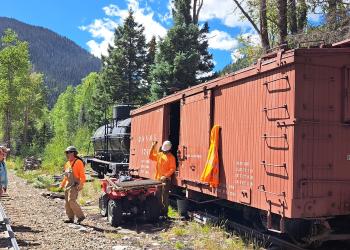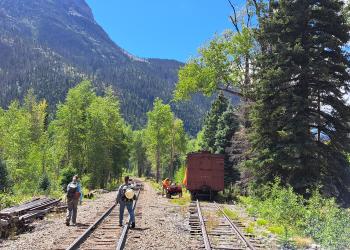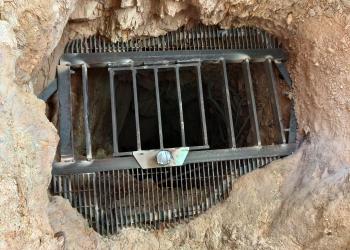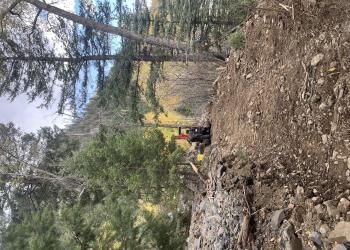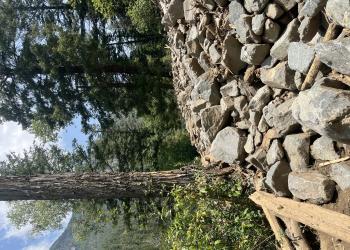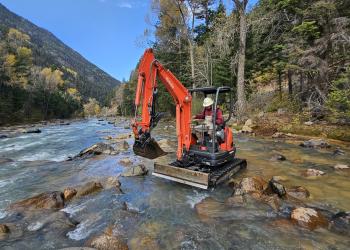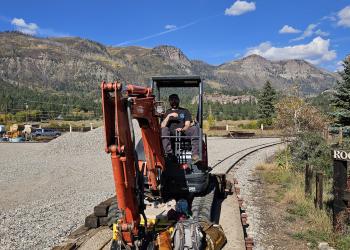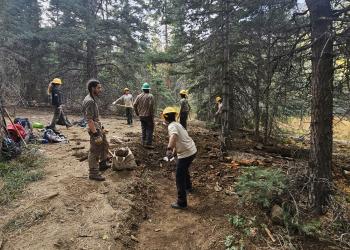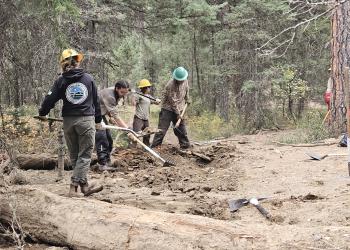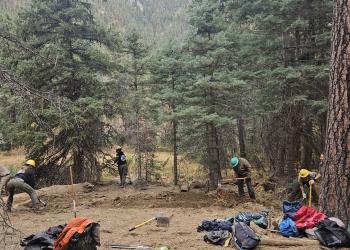Winter 2024 Partnership Peaks
Welcome to winter on the San Juan National Forest!

As the temperatures drop, the days get shorter and the snow starts to stick. On the San Juan, fieldwork moves inside and we start wrapping up last yearʼs details and planning for next yearʼs projects.
Contrary to common out of state public belief, the Forest doesnʼt close for the winter. Roads close to driving and access becomes more specialized, but the Forest remains open to those who are willing to work with the challenges of the snow and cold.
So dig out your backcountry skis, cross country skis, skate skis, snow shoes, snow mobile, snowcat or timber sled. The snow has fallen and the Forest isnʼt open only in the summer.
Safeguarding Abandoned Mines
By James Blair and Abe Proffitt
Coloradoʼs mining history has a rich and vivid legacy. However, this legacy includes thousands of inactive and abandoned mine land features. While some mine sites and structures can appear safe, they often contain unstable soils, unsafe roofs and ladders, deadly odorless gasses, and dangerous explosives. Many mine sites on the San Juan National Forest were related to extracting and processing precious metals as well as Uranium deposits, such as the sites along US 550 toward Red Mountain Pass.
To safeguard these sites from public access, the U.S. Department of Energy office of Management (LM) initiated the Defense Related Uranium Mine (DRUM) Program in 2017. The program is a partnership between the LM, federal land management agencies, and state and Tribal abandoned mine lands (AML) programs to verify and validate the conditions of mines sites across the United States.
These DRUM sites provided uranium ore to the U.S. Atomic Energy Commission (AEC) for defense-related programs between 1947 and 1970. Most of the DRUM closures across the western United States are in desert areas, such as along the Colorado-Utah border between Cortez and Grand Junction; however, a few are located high up in alpine and subalpine environments on San Juan National Forest.
On August 29, 2024, James Blair (San Juan NF Geologist), Emma Reinemann (NEPA Coordinator), and Kirsten Brown (Colorado Division of Reclamation, Mining and Safety, Inactive Mines Reclamation Program) visited one of these sites in the Weminuche Wilderness. Rather than hiking in supplies and gear, researchers and contractors partnered with the Durango Silverton Narrow Gauge Railroad to transport them to the site. High Country Solutions was hired through the DRUM program to close three openings near the railroad while the equipment was hauled in a box car by the railroad, including ATVs, structural steel, welders, saws, and polyurethane foam (PUF).
“Getting that equipment up to the site without the train could have been very expensive and time consuming”, said Blair. “The train was originally built in the 1880s and was promoted as a passenger service rail, but the line was constructed to haul gold and silver ore from the San Juan Mountains to Durango. This project was a great example of using 19th century technology to solve 20th century problems in the 21st century!” As of 2023, the DRUM program has facilitated the closure of 1108 hazardous mine sites and features, predominantly those areas most accessible to the public – and the agency plans to continue safeguarding projects across Colorado. In April 2024, Colorado was awarded $2.8 million through the Office of Surface Mining Reclamation and Enforcement (OSMRE) to address the hazards and environmental degradation of LM sites, eliminating dangerous conditions and pollution caused by past mining.
Animas River Trail Reopened
When mudslides closed the Animas River Trail, solid partnerships made a quick cleanup possible
By Lorena Williams
In June 2024, heavy rains caused landslides along the Animas River, obstructing the Animas River Trail (#675) in three places and covering approximately 1/3 of a mile of the trail with mud, rockfall, and debris. The Animas River Trail is the main access trail for the Chicago Basin, a popular destination in the Weminuche Wilderness, and is managed for both stock and people on foot. "The Animas River canyon is such a unique place on our forest – it’s steep, deep, remote, beloved, and complex to manage," said Columbine Wilderness Manager Kristina Schenck. "Because of all those factors, we relied heavily on support from our partners to help us implement this unforeseen project."
To clear the debris, the San Juan NF would need to transport equipment to the remote area and carve out extra time for trails crews to tackle this obstacle amidst their busy summer trail schedule. So, in mid-October, they partnered with the Durango and Silverton Narrow-gauge Railroad to haul a mini-excavator to the trail. The long-standing partnership betwen Columbine District trail crews and the Durango Train proved critical to reopen the trail. "Train access was an absolute game changer and having that support from the D&SNG for transporting the mini-ex, personnel, and equipment was critical to our success," said Schenk. Special train equipment was made available for the transport, and crews were shuttled by train car to the job site. Without the crew shuttle, an eight-mile hike from Purgatory Flats Trailhead would have been required, and without the equipment shuttle, crews would have needed to clear the landslides by hand--a feat that would take several weeks. Once the Columbine District Trail Crew and Wilderness Crew unloaded the mini-excavator trainside, they donned waders to cross the river and reach the trail and mudslides. For six days, crews camped alongside the railroad tracks, crossing the river each day to the job site.
Following the machine stage of debris removal, another set of critical San Juan NF partners were sought to help finish the job. A Southwest Conservation Corps Crew (SCC) was brought out for eight days to complete finish work on the landslides by hand. The SCC crew time was funded through a long-standing agreement with National Forest Foundation (NFF). According to Nick Olson, Southwest Colorado Project Coordinator for NFF, "The San Juan Stewardship Fund, a partnership between Purgatory Resort, the National Forest Foundation and the San Juan National Forest, provides consistent financial support that allows us to complete unexpected, but necessary maintenance like the Animas River Trail and leverage for larger new projects like the Cutthroat Trail. Those small donations on ski pass purchases and room reservations add up to make a big impact!" Against all odds, the San Juan NF and its partners successfully reopened the Animas River Trail just five months after the slides. It was a heavy lift: coordinating the equipment rental and transportation, securing Southwest Conservation Corps and Columbine trail and wilderness crew time, finding funding--all while timing the work during low water in order to shuttle crews and equipments safely across the water. Thanks for all of your hard work!



